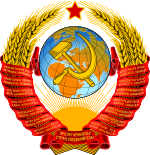Cabinet of Ministers (Soviet Union)
You can help expand this article with text translated from the corresponding article in Russian. (November 2020) Click [show] for important translation instructions.
|
This article needs additional citations for verification. (September 2012) |
 | |
| Agency overview | |
|---|---|
| Formed | 14 January 1991 |
| Preceding agency | |
| Dissolved | 28 August 1991[1] |
| Superseding agency | |
| Jurisdiction | Union of Soviet Socialist Republics |
| Headquarters | Moscow Kremlin in Moscow, RSFSR, Soviet Union later moved to former headquarters of the State Committee for Construction |
| Employees | 55 members (February 1991) |
| Minister responsible | |
The Cabinet of Ministers of the USSR (Russian: Кабинет Министров СССР) served as the administrative and executive body of the Soviet Union after the dissolution of the previous Council of Ministers. Established on January 14, 1991, it was composed of the Prime Minister, seven deputies (including two first deputy prime ministers), and 36 ministers, alongside one state committee. The Cabinet's key decision-making organ was the Presidium, which included the Prime Minister, his deputies, and an Administrator of affairs.
Responsibilities and functions
[edit]The Cabinet of Ministers was responsible for a wide range of functions, including:
- Formulating and executing the All-Union state budget
- Administering defense enterprises and overseeing space research
- Implementing foreign policy and combating crime
- Maintaining defense and social security
- Collaborating with republican governments to develop financial and credit policies
- Administering fuel, power supplies, and transport systems
- Developing welfare and social programs
Additionally, the Cabinet coordinated All-Union policies on science, technology, patents, airspace use, pricing, general economic policy, housing, environmental protection, and military appointments. It had the authority to issue decrees and resolutions.
Structure and composition
[edit]The Cabinet existed alongside other key bodies, such as the Federation Council and the Presidential Council of the Soviet Union, but it was the primary executive organ responsible for the ministers and the economy. The ministries within the Cabinet included:
- Ministry of Agriculture and Food
- Ministry of Defense
- Ministry of Health
- Ministry of Culture
- Ministry of Foreign Affairs
- Ministry of Transport Construction
- Ministry of Environmental Protection
- Ministry of Nuclear Power Industry
Dissolution
[edit]The Cabinet of Ministers was dissolved on August 28, 1991, following a vote of no confidence by the Supreme Soviet. It was subsequently succeeded by the Committee on the Operational Management of the Soviet Economy.
References
[edit]
